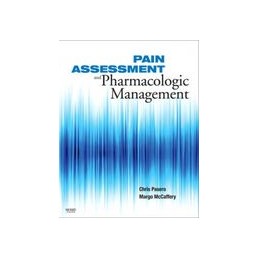- Obniżka


 Dostawa
Dostawa
Wybierz Paczkomat Inpost, Orlen Paczkę, DHL, DPD, Pocztę, email (dla ebooków). Kliknij po więcej
 Płatność
Płatność
Zapłać szybkim przelewem, kartą płatniczą lub za pobraniem. Kliknij po więcej szczegółów
 Zwroty
Zwroty
Jeżeli jesteś konsumentem możesz zwrócić towar w ciągu 14 dni*. Kliknij po więcej szczegółów
Pain Assessment and Pharmacologic Management, by highly renowned authors Chris Pasero and Margo McCaffery, is destined to become the definitive resource in pain management in adults. It provides numerous reproducible tables, boxes, and figures that can be used in clinical practice, and emphasizes the benefits of a multimodal analgesic approach throughout. In addition, Patient Medication Information forms for the most commonly used medications in each analgesic group can be copied and given to patients. This title is an excellent resource for nurses to become certified in pain management.
Opis
Section I: Underlying Mechanisms of Pain Section II: Assessment Introduction 1. Underlying Complexities of Pain Assessment 2. Misconceptions That Hamper Assessment and Treatment of Patients Who Report Pain 3. Assessment Tools for Patients 4. Other Challenges in Pain Assessment Conclusion References Section III: Nonopioid Analgesics Introduction 5. Indications for Administration of Acetaminophen or NSAIDs 6. Adverse Effects of Acetaminophen and NSAIDs 7. Individualizing the Selection of Nonopioid Analgesics 8. Perioperative Nonopioid Use 9. Nonprescription Nonopioids 10. Acute Overdose Conclusion References Section IV: Opioid Analgesics Introduction 11. Physiology and Pharmacology of Opioid Analgesics 12. Key Concepts in Analgesic Therapy 13. Guidelines for Opioid Drug Selection 14. Guidelines for Selection of Routes of Opioid Administration 15. Intraspinal Analgesia (Epidural and Intrathecal) 16. Initiating Opioid Therapy 17. IV Patient-Controlled Analgesia 18. Switching to another Opioid or Route of Administration 19. Management of Opioid-Induced Adverse Effects 20. Unwarranted Withholding of Opioids Conclusion References Section 5: Adjuvant Analgesics Introduction 21. General Considerations in the Use of Adjuvant Analgesics 22. Multipurpose Adjuvant Analgesics 23. Adjuvant Analgesics for Persistent (Chronic) Neuropathic Pain 24. Topical Analgesics for Persistent (Chronic) Pain 25. Adjuvant Analgesics for Musculoskeletal Pain 26. Adjuvant Analgesics for Postoperative and Other Acute Pain 27. Adjuvant Agends for Goal-Directed Sedation in the Critically Ill and Procedural Sedation 28. Local Anesthetics for Procedural Pain 29. Adjuvant Analgesics for Persistent (Chronic) Bone Pain 30. Adjuvant Analgesics for Malignant Bowel Obstruction 31. Adjuvants Less Often Used Conclusion References Appendix A: Pain Resources on the Internet Appendix B: Opioid Agreements Appendix C: Use of Electronic Medical Records in Pain Management Appendix D: Terminology
